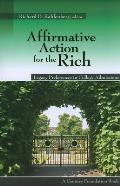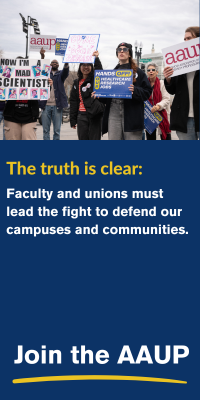- About
- Programs
- Issues
- Academic Freedom
- Political Attacks on Higher Education
- Resources on Collective Bargaining
- Shared Governance
- Campus Protests
- Faculty Compensation
- Racial Justice
- Diversity in Higher Ed
- Financial Crisis
- Privatization and OPMs
- Contingent Faculty Positions
- Tenure
- Workplace Issues
- Gender and Sexuality in Higher Ed
- Targeted Harassment
- Intellectual Property & Copyright
- Civility
- The Family and Medical Leave Act
- Pregnancy in the Academy
- Publications
- Data
- News
- Membership
- Chapters
The Largest Affirmative Action Program in American Higher Education
Affirmative Action for the Rich: Legacy Preferences in College Admissions. Richard D. Kahlenberg, ed. New York: Century Foundation Press, 2010.
While the practice of race-based affirmative action in higher education has been extensively debated, a larger and older form of preferential admissions treatment has received remarkably scant attention. In Affirmative Action for the Rich: Legacy Preferences in College Admissions, editor Richard D. Kahlenberg has assembled an impressive array of scholars, journalists, and legal practitioners who consider the origins and extent of admissions preferences for children of alumni; the philosophical, legal, and policy issues these so-called legacy preferences raise; their impact on university fund-raising; and their implications for civil rights. Together, the ten chapters in this volume help to break the relative silence on legacy preferences and make a substantial and vitally important contribution to discussions of the role these preferences play in university admissions.
In spite of the fact that three out of four Americans believe that colleges should do away with legacy admissions, the consideration of legacy status in admissions decisions remains widespread. In the first part of the volume, Chronicle of Higher Education writer Peter Schmidt provides a historical overview of legacy preferences, journalist Daniel Golden contributes an analytical survey of the use of legacy preferences today, and law professor John Brittain and attorney Eric L. Bloom consider the effect of legacy preferences on students of color. Nearly all selective private institutions and liberal arts colleges as well as most flagship public universities employ admissions policies favoring the children of alumni. Upward of 90 percent of all top-tier institutions explicitly consider legacy status in admissions. Top universities admit legacies at rates two to five times higher than overall acceptance rates, and consequently children of alumni make up 10 to 25 percent of the student body at selective institutions. Once enrolled, legacy students underperform academically in comparison to classmates from similar demographic backgrounds.
The equity of admissions preferences merits careful scrutiny because of its considerable consequences. Graduating from a selective institution enhances one’s life chances and increases the likelihood of entering a position of corporate or political leadership. Legacy preferences compound existing inequalities by providing admissions benefits to the already enormously advantaged population of largely white, affluent, and privileged children of alumni— exactly the population that is already most likely to attend selective institutions. Because so few legacies are black or Latino, legacy policies have a disparate negative impact on these “wrong ancestor” students. By advancing individuals on the basis of bloodline, legacy policies limit racial and economic diversity on college campuses and subsequently in workplaces and in economic and political power structures.
Colleges and universities have generally attempted to justify legacy preferences through two principal arguments. They claim that legacy preferences ensure the high level of alumni donations on which they depend and that legacy admissions help colleges maintain a sense of tradition and community by ensuring that a proportion of each class arrives with a sense of history and connection to the institution. Authors in this volume challenge both of these rationales. Universities like the California Institute of Technology have never employed legacy preferences but continue to maintain high alumni donations. Further, after dropping legacy preferences, some institutions, like the University of California, the University of Georgia, and Texas A&M University, saw increases in alumni giving. Finally, contributors Chad Coffman, Tara O’Neil, and Brian Starr present statistical analyses that cast doubt on the causal claim that legacy preferences lead to increased levels of alumni donations: while institutions employing legacy preferences do see higher levels of giving, the relationship can be explained entirely by the wealth of the admitted students. Legacy preferences ultimately allow institutions to overselect from the pool of their own wealthy alumni. Institutions wishing to increase the number of their students with a connection to the history and tradition of the campus could more efficiently select on this basis through the applicants’ essays.
Several scholars in this volume call into question the philosophical and legal basis of legacy preferences. Michael Lind of the New America Foundation contends that legacy preferences stand at odds with the Jeffersonian ideal of a democratic republic built on an aristocracy of virtue and talent by instead promoting political, economic, and educational aristocracy. Law professor Carlton F. W. Larson goes further in calling legacy preferences grossly unconstitutional because they are a form of unearned hereditary privilege descending from parent to child, in violation of constitutional rules that prohibit hereditary privileges. Attorneys Steve Shadowen and Sozi P. Tulante assert that preferences are unlawful in both public and private universities and can be legally challenged as a violation of the Equal Protection Clause of the Fourteenth Amendment to the Constitution and the Civil Rights Act of 1866. Judge Boyce F. Martin Jr. and attorney Donya Khalili present an overview of how a judge would likely weigh the legal ramifications of admissions preferences along with the justifications the universities would make. Taking a different tack, education writer Peter Sacks questions whether alumni donations should be tax-deductible for donors who give expecting a future reciprocal benefit in the form of enhanced admissions consideration for their children. Charitable deductions rest on the principle that donations for nonprofit organizations do not “enrich the giver,” and Sacks calls for an end to these tax breaks, which constitute a systematic abuse of the tax system.
The widespread use of legacy preferences among America’s top universities casts grave doubt on these institutions’ commitment to meritocracy and equal opportunity. That as a country we would stand for these ancestry-based discrimination practices is deeply disturbing. Even if legacy preferences were found to correlate with alumni donations, why should raising money from the beneficiaries of discrimination be considered anything less than corrupt? Yet even a modest 2003 congressional proposal to require institutions to disclose more information on legacy admissions failed, and after a brief period of heated interest in the topic of legacy preferences through the 2004 election, members of Congress seem to have set the issue aside (possibly because so many of them, as graduates from elite institutions, either have benefited from legacy preferences or expect their children to be able to do so). Perhaps the outstanding collection of papers in Affirmative Action for the Rich will serve not only to inform but also to galvanize public opinion and incite long-overdue action.
Ann L. Mullen is associate professor of sociology at the University of Toronto and the author of Degrees of Inequality: Culture, Class, and Gender in American Higher Education. Her e-mail address is [email protected].




